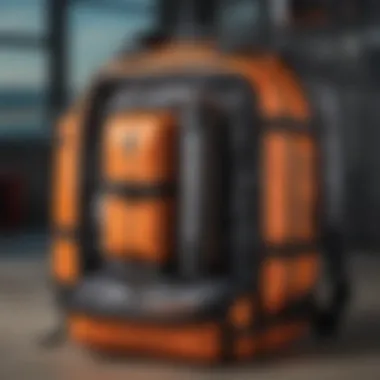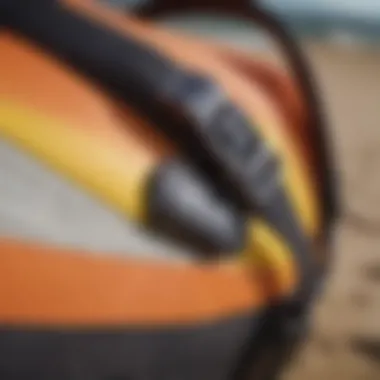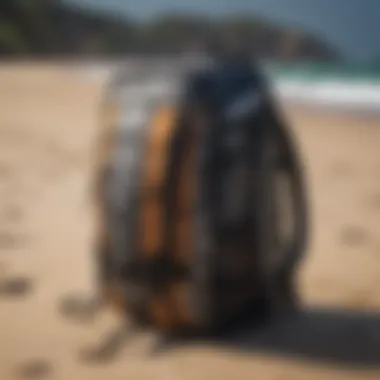The Ultimate Guide to Choosing Your Kite Surfing Bag


Intro
Kite surfing is an increasingly popular extreme sport that blends the thrill of surfing with the exhilarating experience of flying. As kite surfers traverse waters, relying on wind for propulsion, proper gear becomes essential for both safety and performance. At the core of this gear is the kite surfing bag, which serves a vital role. In this guide, we will delve into the essential features, types, and maintenance of kite surfing bags, contributing to a better gear selection process for both novice and advanced kite surfers.
Extreme Sport Overview
Preamble to Kite Surfing
Kite surfing, or kitesurfing, emerged in the late 20th century, evolving from earlier kite-flying techniques used for various purposes. By the 1990s, it had distinguished itself as a unique blend of surfing, windsurfing, and paragliding. This sport requires skillful manipulation of a depowered kite alongside a surfboard, enabling navigation across expansive bodies of water. With the right conditions, practitioners can perform remarkable jumps and aerial tricks, showcasing talent and creativity.
Brief History
Kite surfing's origins can be traced back to experiments with kites in the flying sports world. The concept gained traction when innovators began to craft specially designed kites suitable for water sports. Early enthusiasts strived to perfect kite designs and techniques, leading to the widening acceptance of kite surfing as a mainstream sport. Today, global events and competitions further legitimize kite surfing, propelling rising athletes into prestigious contacts.
Equipment Required
While kite surfing mainly revolves around the kite and surfboard, a kite surfing bag is an often overlooked yet significant piece of equipment. A high-quality kite surfing bag ensures safe transport of essential gear, including:
- Larger kite
- Board
- Harness
- Leash
- Safety gear
In its versatility, the kite surfing bag can also comfortably house the apparel needed for the session.
Safety Tips and Guidelines
Like every extreme sport, safety remains paramount in kite surfing. Some essential safety guidelines include:
- Understanding wind conditions appropriately.
- Using a leash to secure equipment.
- Wearing a life vest and a helmet where necessary.
- Familiarizing yourself with emergency procedures, ensuring readiness for any mishaps.
Proper gear and awareness significantly reduce risks during sessions.
Relevant Statistics and Facts
According to the International Kiteboarding Organization, millions now enjoy kite surfing worldwide. This has extended to various events, both championship and community-driven. Adventure sports entice individuals looking for adrenaline-fueled experiences while presenting deeper lifestyle aspects associated with challenges and engagement within nature.
Kite surfing is not only thrilling but also develops essential physical and mental skills, pushing practitioners to interact with elements in a sophisticated manner.
As we proceed, this guide will explore the diverse features that kite surfing bags offer, providing insights that will help both eager beginners and advanced practitioners make astute decisions regarding their gear.
Understanding Kite Surfing Bags
Kite surfing bags serve a vital role in the world of kite surfing. Their importance cannot be overstated. These bags are not just protecting gear; they are essential for portability and organization. A well-chosen kite surfing bag can significantly enhance the kite surfing experience, both for novice and experienced athletes. The right bag keeps equipment secure and makes it easy to transport and store, addressing the unique challenges faced by kite surfers.
Definition and Purpose
Kite surfing bags are designed to hold and protect the various components of kite surfing equipment. This includes the kite itself, control bars, lines, harnesses, and other essential items. The primary purpose of these bags is to extend the life of kite gear by shielding it from dirt, water, and physical impacts during transport. By keeping the equipment organized, surfers can save time and reducing stress when preparing for their sessions on the water.


Key functions of these bags include:
- Protection: They prevent damage from external factors.
- Organization: Bags help keep things in order, making it easier to find equipment when needed.
- Portability: Good bags provide ease of transport, making it less hassle to carry to and from the beach.
- Durability: With the right choice, a bag can withstand tough treatment and weather conditions.
Evolution of Kite Surfing Bags
The design and functionality of kite surfing bags have evolved significantly since the sport's inception. Originally, many surfers relied on simple backpacks or unstructured bags to carry their gear. These options often lacked necessary protections and made carrying multiple items cumbersome.
As the sport gained popularity and understanding of equipment increased, specialized kite surfing bags emerged. Manufacturers began using more robust materials to ensure durability and weather resistance. This evolution has resulted in a variety of styles, such as single kite bags and multi-kite bags, designed to cater to different needs.
Recent advancements include:
- Use of modern materials: High-tech synthetic fabrics improve resistance to wear and tear.
- Water-resistant designs: Innovative coatings protect equipment from elements like rain and splashes.
- User-friendly features: These include padded compartments, adjustable straps, and customizable storage options.
Key Features of Kite Surfing Bags
When kite surfing, the right packaging for your gear is vital. Kite surfing bags are not just ordinary bags; their design and features play a significant role in protecting and transporting equipment. This section explores key features that a kite surfing bag should have, providing important insights to help participants, whether new or seasoned, select an optimal bag.
Material Durability
The material construction of a kite surfing bag is a major factor when considering its longevity and effectiveness. High-quality materials, such as reinforced polyester or nylon, offer excellent proofing against water, abrasion, and the hot sun, which can wreak havoc on gear. Some bags incorporate additional layers from synthetic fabrics and protect directional pads. This combination can enhance resistance to wear and tear, which is particularly important in extreme environments. Additionally, check for waterproof zippers and seams, as these enhance an overall protection while ensuring easy access when needed. Investing in a robust kite surfing bag often results in long-term savings by reducing the risk of equipment damage.
Size and Storage Capacity
Every kite surfer has a unique setup which can include various kinds of kites, boards, and accessories. Therefore, it’s essential to choose a bag designed with ample space to accommodate everything you own. A well-structured bag should provide organized compartments that keep up with a kite surfer’s needs. Adjustable sizing is a notable feature as well; certain bags expand or compress based on current requirements. Look for optimized design methods that justify every bit of used space. For those planning trips that take equipment on the road or air, pay special attention to weight limits of storage sizes.
Padding and Protection
With technology in evolvement, some kite surfing bags utilize molded designs to offer yet more protective measures—that results in gear staying safe from chocks or impacts while in transit. Thoughtful padding in critical areas makes notably contributes; it minimizes movements and secures specific pieces inside the bag. Such features are fundamental in preventing the damages caused by vibration a fisherman might face while navigating rough land or torn up paths or during luggage handling at an airport. Guarding valuable gear is pivotal and inadequate padding is a assumption no kite surfer should make, so maximized birthday protection is simply prestigious.
Portability and Straps
The ease of carrying kite surfing bags is a feature that often gets disregarded but is indeed significant. A bag can be durable yet unwieldy to handle. Consider bags sporting adjustable, padded shoulder straps along with comfortable handles. Some models find a merit due to the inclusion of ergonomically-designed straps that disperse weight calls more convenient experiences when transitioning locations or simply dealing with airport trips. There are also roller bags with wheels that give optinal deployment options. Less burden on the human factor is crucial to prevent physical drags exacerbated by the weight of kite tools and equipment.
"Investing in a kite surfing bag with the right features can significantly enhance your enjoyment and experience in the sport. Proper material durability, size considerations, suitable padding, and effective portability should shape your choice."
Types of Kite Surfing Bags
Understanding the various types of kite surfing bags is crucial for anyone involved in this sport. Each type of bag serves a distinct purpose, catering to different preferences and needs. Recognizing these differences allows kite surfers to make educated decisions that align with their activity requirements, whether for daily sessions or travel. Selecting the right bag can greatly enhance the efficiency of transporting gear and protecting investments over time.
Single Kite Bags
Single kite bags are typically designed to hold one kite, offering a snug fit. They are often favored by those who frequently switch between different types of kites for various conditions. These bags are generally compact and lightweight, which is a strong advantage when trekking to your desired surfing spot.
- Light Weight: Easy to carry, essential for setup.
- Less Volume: Ideal for minimalists or one-kite surfers.
- Tailored Fit: Specific for kite type ensures better protection.
Such bags usually include elements for personal comfort, like handles and adjustable straps. They come in a variety of materials, usually rip-stop fabric that keeps them resistant to wear and tear. A notable detail is the inclusion of a pocket, for stashing small accessories like lines, valves, or personal items, creating an organized sporting experience.


Multi-Kite Bags
Multi-kite bags are advantageous for those whose activity involves multiple kites. This type is targeted toward enthusiasts who want a single solution to hold it all—kites, boards, and other needed items. The larger storage capacity of these bags means you should also carefully consider organization—for people who kite in various conditions, having a well-structured bag is critical.
- Enhanced Capacity: Suitable for travel routes with multiple kites.[see link]
- Segregation Options: Help keep kites separated, avoiding damage.
- Multiple Purchase: Sword of choices as per adaptabilities in kite styles.
Many multi-kite bags equip compartments to easy access your gear and meet individual kite surfer needs. Zippered compartments can hold accessories securely and safely during transport.
Hybrid Bags
Hybrid bags offer versatility by integrating features from both single and multi-kite bags. Those who frequently change styles or are unsure about their specific needs will find these bags to be particularly appealing. The hybrid design caters to those who need extra space without lugging around unnecessary weight.
- Dynamic Choices: An option for both one and more kites.
- Functionality: Typically includes sky optimal thickness in compartments, lending strength.
- Organizational Benefits: Maximum adaptability in smaller frame.
Ultimately, choosing a hybrid bag can revolve around finely tuned preferences. This type offers flexibility without ceding valuable performance aspects that kite surfers demand.
Travel Bags
Travel bags are specially constructed for long distances and often cross borders, providing appropriate methods to manage costly gear during transit. Most jet-off clutch travelers, or those routine cross country adventurers, benefit from the design intent to protect the contents rigorously. These bags come padded to reduce impacts and also usually fit into airplane overhead compartments.
- Protection Focus: Designed to withstand transit rigors.
- Numerous Compartments: Allow organized packing; every item has its spot.
- Uniform Sizing: Fitting industry standards eases travels.
It is important for care adapters to note their length and size to safeguard their gear thoroughly on international journeys where mishandling frequently arises.
Selecting the suitable type of kite surfing bag can significantly extend the lifespan of your gear while making your experiences in kite surfing more fluid and enjoyable.
Selecting the Right Kite Surfing Bag
Selecting a kite surf bag is critical for anyone invested in the sport. This decision affects both performance and convenience. A well-chosen bag offers protection for equipment, aids in organization, and enhances transport, making it essential to understand your options before buying.
Assessing Individual Needs
Individual needs vary significantly among kite surfers. Someone who frequently travels may require a larger bag that holds multiple kites, while a weekend warrior might only need a smaller, single-kite bag.
Consider elements such as:
- Travel frequency: Regular flyers need durability and handling ease.
- Equipment types: Ensure compatibility with kite sizes and related gear.
- Style of use: Assess whether you practice in diverse conditions; you might require more protection.
- Storage capacity: Look for pockets and compartments to store smaller items like lines or tools.
Based on these factors, select a bag that fits these preferences well. It facilitates ease of transport and preserves gear lifespan.
Evaluating Brand Options
Brand selection also impacts bag functionality and reliability. Certain brands dominate the kite surfing market, offering various innovations and designs. Researching these options is beneficial. Consider:
- Reputation: Brands like Naish, Cabrinha, and Slingshot are known for quality.
- User reviews: Feedback from other kite surfers often reveal practical insights.
- Warranty offers: Strong warranty support can indicate company confidence in their product.
- Innovative technologies: Pay attention to brands incorporating climate-resilient materials. Innovation can enhance durability.
Familiarize yourself with specific product lines to refine choices further. Choosing a favored brand may provide peace of mind knowing that the bag hits high standards.


Price Considerations
Cost plays an undeniable role in decision-making. Price often correlates with quality in kite surf bags so it's important to remember that spending a bit more may result in a bag that lasts longer. Consider these price-related factors:
- Budget: Set a realistic budget based on your needs and preferred brand reputation.
- Long-term value: Cheaper products might lack durability. Consider the potential for replacement costs.
- Sales and discounts: Regular surfing seasons sometimes bring sales at specialty retailers. Monitor for deals.
Educating yourself about the marketplace regarding pricing might help you discover good bargains without compromising quality.
Maintaining Kite Surfing Bags
Maintaining kite surfing bags is essential for any serious athlete. These bags are more than just a means of carrying gear; they protect valuable equipment, enhance flow efficiency, and can impact an athlete's overall experience on the water. Proper care and routine maintenance can prolong the lifespan of a kite surfing bag, whether you are a novice taking up the sport or a seasoned veteran.
Cleaning Procedures
Keeping your kite surfing bag clean is vital. Sand, salt water, and dirt can accumulate, leading to wear and tear over time. Follow these procedures for effective cleaning:
- Empty the Bag: Before cleaning, ensure the bag is completely empty. Remove all kites, bars, and other equipment.
- Rinse with Fresh Water: Use fresh water to rinse the exterior of the bag. This helps remove saltwater and sand, which can damage materials if left untreated.
- Mild Soap Application: Use a mild soap along with a sponge or cloth to gently scrub the surface. Avoid abrasive cleaners, which can damage the fabric.
- Thorough Drying: After cleaning, let the bag air dry completely before storing it. This precaution prevents mold and mildew growth.
Important: Regular cleaning maintains not only the aesthetics of the bag but also the functionality.
Storage Recommendations
Proper storage of a kite surfing bag is crucial to maintaining its integrity. Here are a few tips on how to store your bag effectively:
- Avoid Excessive Weight: When storing your bag, do not overload it with additional gear. This can strain the zippers and seams, causing premature damage.
- Store in a Cool, Dry Place: Keep your bag in a well-ventilated area to avoid moisture buildup that leads to mold. Stress on fabrics can occur from heat exposure, so ideal storage is away from direct sunlight.
- Use Compression Straps: If available, make use of compression straps to minimize space and limit movement of the contents during storage. It helps keep things organized and tidy.
- Inspect Regularly: As part of an ongoing maintenance routine, inspect the bag for signs of wear, such as frayed zippers or weakened seams. Address any issues immediately to avoid broader problems later.
By adhering to these maintenance and storage guidelines, kite surfers can ensure their bags remain functional and last for years. Consistent care demonstrates commitment not only to equipment but to the sport itself.
The End
In understanding kite surfing bags, we explore more than just a piece of equipment. The proper bag is integral to a kite surfer’s experience, merging functionality and durability with the very essence of the sport. Selecting an adequate bag enables surfers to protect their gear efficiently, making transport to different locations much easier. Each bag type, from single kite bags to multi-kite bags, addresses a unique need based on the surfer's profile.
The aggregation of information highlighted throughout this article illustrates key elements crucial for informed decision-making. Hooding points arise when you interpret certain specifications like material and safety features, reinforcing the significance of a good cycling gear portfolio. Maintenance considerations discussed guide novice and experienced surfers alike in prolonging their bags’ lifespan.
Understanding this landscape ensures that your adventures remain uninterrupted, letting you focus on achieving new heights in your kite surfing practice. Different materials used in making these bags, from thin nylon to expertly-designed tarpaulins, also hints towards a quick connectivity with advancements in outdoor gear. This connection sparks a more enriching surfing journey as you seamlessly integrate new trends into your equipment choices.
Lastly, by grasping what elements affect bag design, you gear yourself not solely for now but also keep an eye towards what innovations may come. Evaluating choices with clear parameters familiarizes you with the best options for budget, builds, and brand recommendation.
"A quality kite surfing bag is more than convenience; it's about enhancing your performance while safeguarding your valued gear."
Summary of Key Points
- The kite surfing bag must fit individual needs based on frequency of travel and level of surf competency.
- Recognizing the significance of material durability can majorly influence safety of gear protection.
- Different bag types are integral for convenience and may define the nature of excursions.
- Maintenance practices uplift utility while increased brand options offer competitive choices.
Future Trends in Kite Surfing Bag Design
Looking forward, we can expect several advancements in the design of kite surfing bags, each catering to evolving needs of surfers. Sustainable materials are gaining traction, reflecting a global shift towards eco-friendly options wherever possible. This trend not just reduces ecological impact, but also offers enhanced durability.
Smart technology integration is another frontier. Imagine incorporating collapsible compartments that deploy as necessary or GPS technology for tracking equipment shows potential to add convenience in high-stakes environments.
Lastly, customizable designs allow for differentiation in a crowded market, where personalization caters not only to aesthetic values but practical preferences as well. The trends herald a rich environment for thorough enhancement in kite gear, aligning ride expectations with overall performance, redefining experiences requently.
Awareness and adaptation of these innovative trajectories signify that kite surfers will continually elevate their participation within the sport.



